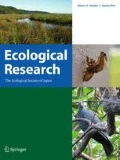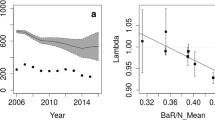Abstract
We evaluated relative density indices of sika deer (Cervus nippon) to aid in population management. We monitored sika deer population trends from 1992 to 2002 in the eastern part of Hokkaido Island, northern Japan, using spotlight surveys, aerial surveys, catch per unit effort (CPUE), sighting per unit effort (SPUE), and cost of damage to agriculture and forestry. We assumed that the artificial bias in the spotlight index would be lower than in other indices, and compared temporal patterns of other indices to those produced using spotlight surveys using model II regression. There was a significant correlation between the damage cost index and the spotlight index, and both indices indicated consistent population trends. Managers used CPUE as a tool to determine hunting quota efficiency. The SPUE index had the smallest standard error among the indices, and the spotlight survey index had the second smallest standard error. Overall, the spotlight survey was the most useful index because its estimate error was small and it was precise in showing population trends; however, spotlight surveys did lead to underestimation once in 1994. The SPUE index seems to be effective in checking the validity of the spotlight index, but there are so many environmental and demographic uncertainties that several independent indices should be used and crosschecked for accurate evaluation of population trends.




Similar content being viewed by others
References
Akitaya E, Naruse R, Shiraiwa T (1994) Weather and snow conditions in Akan National Park. In: Katsui Y (eds) The nature of Akan National Park, 1993 (in Japanese). Maeda Ippoen Foundation, Hokkaido, Japan, pp 219–262
Anderson RD (2001) The need to get the basics right in wildlife field studies. Wildl Soc Bull 29:1294–1297
Begon M, Harper JL, Townsend CR (1996) Ecology: individuals, populations and communities, 3rd edn. Blackwell Science, London
Buckland ST, Anderson DR, Burnham KP, Laake JL, Borchers DL, Thomas L (2001) Introduction to distance sampling. Oxford University Press, Oxford
Caughley G (1977) Analysis of vertebrate populations. Wiley, New York
Cochran WG (1977) Sampling techniques. 3rd edn. Wiley, New York
Engeman RM (2003) More on the need to get the basics right: population indices. Wildl Soc Bull 31:286–287
Gasaway WC, DuBois SD, Reed DJ, Harbo SJ (1986) Estimating moose population parameters from aerial surveys. Biological Papers of the University of Alaska, no. 22, p 108
Hokkaido Government (1998) Conservation and management plan for sika deer (Cervus nippon) in Eastern Hokkaido (in Japanese). Department of Environment and Lifestyle, Hokkaido Government, Sapporo, Japan, p 16
Hokkaido Government (2001) A report of exploitation of venison and measures for reducing damage to agriculture (in Japanese). Department of Agriculture, Hokkaido Government, Sapporo, Japan, p 92
Hokkaido Government (2002) Conservation and management plan for sika deer (Cervus nippon) in Hokkaido (in Japanese). Department of Environment and Lifestyle, Hokkaido Government, Sapporo, Japan, p 18
Hokkaido Institute of Environmental Sciences (1994) Distribution of sika deer and brown bear on Hokkaido (in Japanese). Hokkaido Institute of Environmental Sciences, Sapporo, Japan, p 63
Hokkaido Institute of Environmental Sciences (1995) Results of a survey related to sika deer and brown bear on Hokkaido (in Japanese). Hokkaido Institute of Environmental Sciences, Sapporo, Japan, p 164
Igarashi T (1986) Forest vegetation of Akan National Park, Hokkaido, Japan. Research Bulletin of the College Experiment Forests, vol 43 (in Japanese with English summary). Faculty of Agriculture, Hokkaido University, pp 335–494
Igota H (2004) Migration strategy and its cost of female sika deer in eastern Hokkaido, Japan. DC thesis. Laboratory of Boreal Forest Conservation, Graduate School of Agriculture, Hokkaido University, Japan, p 88
Japan Weather Association (1991) Climate of Hokkaido (in Japanese). Japan Weather Association, Hokkaido Regional Head Office, Sapporo, Japan, p 359
Kaji K (1995) Deer irruption: a case study in Hokkaido, Japan (in Japanese). Honyurui Kagaku (Mammalian Science) 35:35–43
Kaji K, Tomizawa M (1993) Census methods and evaluation of the sika deer population on Hokkaido (in Japanese). Honyurui Kagaku (Mammalian Science) 32:127–134
Kaji K, Matsuda H, Uno H, Hirakawa H, Tamada K, Saito T (1998) Sika deer management in Hokkaido (in Japanese). Honyurui Kagaku (Mammalian Science) 38:301–313
Kaji K, Okada H, Yamanaka M, Matsuda H, Yabe T (2004) Irruption of a colonizing sika deer population. J Wildl Manage 68:889–899
Koganezawa M, Li Y (2002) Sika deer response to spotlight counts: implications for distance sampling of population density. Mammal Study 27:95–99
Matsuda H, Kaji K, Uno H, Hirakawa H, Saitoh T (1999) A management policy for sika deer based on sex-specific hunting. Res Popul Ecol 41:139–149
Matsuda H, Uno H, Tamada K, Kaji K, Hirakawa H, Saitoh T, Kurumada K, Fujimoto T (2002) Harvest-based estimation of population size for sika deer on Hokkaido Island, Japan. Wildl Soc Bull 30:1160–1171
Muroyama Y (2003) To get along with monkeys living around villages: wildlife damage management (in Japanese). Kyoto University Press, Kyoto, Japan
Nagata J, Masuda R, Kaji K, Kaneko M, Yoshida MC (1998) Genetic variation and population structure of the Japanese sika deer (Cervus nippon) on Hokkaido Island, based on mitochondrial D-loop sequences. Mol Ecol 7:871–877
Novak JM, Scribner KT, Dupont WD, Smith MH (1991) Catch-effort estimation of white-tailed deer population size. J Wildl Manage 55:31–38
Ooi T, Suzuki M, Horino S, Miura S (1993) Comparison of aerial and ground counts for wild sika deer (Cervus nippon) (in Japanese with English summary). Honyurui Kagaku (Mammalian Science) 33:1–8
Sakuragi M, Igota H, Uno H, Kaji K, Kaneko M, Akamatsu R, Maekawa K (2003) Seasonal habitat selection of an expanding sika deer (Cervus nippon) population in eastern Hokkaido, Japan. Wildl Biol 9:141–153
Samuel MD, Garton EO, Schlegel MW, Carson RG (1987) Visibility bias during aerial surveys of elk in northcentral Idaho. J Wildl Manage 51:622–630
Sokal RR, Rohlf FJ (1995) Biometry. 3rd edn. WH Freeman and Company, New York
Thompson WL, White GC, Gowan C (1998) Monitoring vertebrate populations. Academic Press, San Diego
Uno H, Kaji K (2006) Survival and cause-specific mortality rates of female sika deer in eastern Hokkaido, Japan. Ecol Res 21:215–220. DOI 10.1007/s11284-005-0111-4
Uno H, Yokoyama M, Takahashi M (1998) Winter mortality pattern of Sika deer (Cervus nippon yesoensis) in Akan National Park, Hokkaido (in Japanese with English summary). Honyurui Kagaku (Mammalian Science) 38:233–246
Walters C (1986) Adaptive management of renewable resources. Macmillan, New York
Whipple JD, Rollins D, Schacht WH (1994) A field simulation for assessing accuracy of spotlight deer surveys. Wildl Soc Bull 22:667–673
White GC (2001) Why take calculus? Rigor in wildlife management. Wildl Soc Bull 29:380–386
Acknowledgements
We are very grateful to T. Akasaka, T. Fujimoto, T. Kurumada, M. Suzuki, M. Yamanaka, and H. Yokomizo for supporting our work and stimulating discussions. We thank Abashiri, Kushiro, Nemuro, and Tokachi Subprefectural Office, and the Hokkaido Hunters’ Association for assisting with the collection of data. We also acknowledge the assistance of anonymous referees and an editor for critically reading and helping to improve the manuscript. This study was supported by the Hokkaido Government.
Author information
Authors and Affiliations
Corresponding author
About this article
Cite this article
Uno, H., Kaji, K., Saitoh, T. et al. Evaluation of relative density indices for sika deer in eastern Hokkaido, Japan. Ecol Res 21, 624–632 (2006). https://doi.org/10.1007/s11284-006-0158-x
Received:
Accepted:
Published:
Issue Date:
DOI: https://doi.org/10.1007/s11284-006-0158-x




